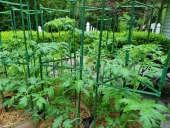








Visit Redhawk's soil series: https://permies.com/wiki/redhawk-soil
How permies.com works: https://permies.com/wiki/34193/permies-works-links-threads




Jay Angler wrote:I'd love it if you could post a picture - maybe there's a web example? Here are my initial thoughts.
Have you considered using the cages to get the plants started, but putting a taller tripod over them for the height you need?
These may have been designed for dwarf or determinant tomatoes - maybe consider that for next year?
Have you considered growing bush beans in them? In my climate, I find that bush beans benefit from some support (lots of dew increasing mold risk - supporting the plants is a cheap, easy way to lower the risk and makes them a little easier to pick as well).




Invasive plants are Earth's way of insisting we notice her medicines. Stephen Herrod Buhner
Everyone learns what works by learning what doesn't work. Stephen Herrod Buhner
 2
2




 1
1




Absolutely - I knew there was another crop I used to use them on, but I've given up on cucumbers because our weather just doesn't grow them that well - I make zucchini pickles instead!maybe I can use them as cucumber supports too.
Visit Redhawk's soil series: https://permies.com/wiki/redhawk-soil
How permies.com works: https://permies.com/wiki/34193/permies-works-links-threads




Visit Redhawk's soil series: https://permies.com/wiki/redhawk-soil
How permies.com works: https://permies.com/wiki/34193/permies-works-links-threads




"When the whole world is running towards a cliff, he who is running in the opposite direction appears to have lost his mind." C.S. Lewis
Visit https://themaineingredient.com for organic, premium dried culinary herbs that are grown, processed, and packaged in the USA.













 1
1




Jay Angler wrote:Sorry Ralph - I cross posted with you - great minds think alike!
Laurel, are you growing strawberries? If you have spares early in the season, putting them up in you strawberry patch so you can throw bird mesh over the top may be useful. I've put low tunnel hoops up over my strawberry bed for that reason. I lift one side of the mesh and pick, then got to the other side and lift there and I don't have to worry about leaves growing up through the holes.

|
CLUCK LIKE A CHICKEN! Now look at this tiny ad:
The new kickstarter is now live!
https://www.kickstarter.com/projects/paulwheaton/garden-cards
|






